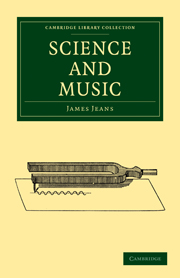Summary
We have now considered the generation of sound and its transmission through the air to the ear; we must finally consider its reception by the ear, and transmission to the brain.
When the air is being traversed by sound-waves, we have seen that the pressure at every point changes rhythmically, being now above and now below the average steady pressure of the atmosphere—just as, when ripples pass over the surface of a pond, the height of water in the pond changes rhythmically at every point, being now above and now below the average steady height when the water is at rest. The same is of course true of the small layer of air which lies in contact with the ear-drum, and it is changes of pressure in this layer which cause the sensation of hearing. The greater the changes of pressure, the more intense the sound, for we have seen that the energy of a sound-wave is proportional to the square of the range through which the pressure varies.
The pressure changes with which we are most familiar are those shewn on our barometers—half an inch of mercury, for instance. The pressure changes which enter into the propagation of sound are far smaller; indeed they are so much smaller that a new unit is needed for measuring them—the “bar”. For exact scientific purposes, this is defined as a pressure of a dyne per square centimetre, but for our present purpose it is enough to know that a bar is very approximately a millionth part of the whole pressure of the atmosphere.
- Type
- Chapter
- Information
- Science and Music , pp. 217 - 252Publisher: Cambridge University PressPrint publication year: 2009First published in: 1937

